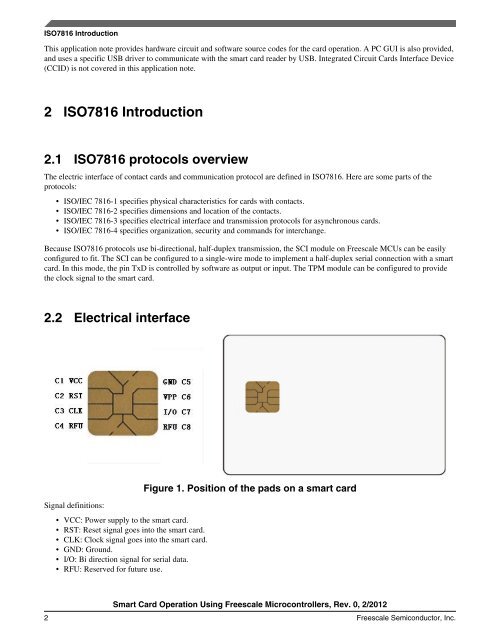AN4453, Smart Card Operation Using Freescale Microcontrollers ...
AN4453, Smart Card Operation Using Freescale Microcontrollers ...
AN4453, Smart Card Operation Using Freescale Microcontrollers ...
You also want an ePaper? Increase the reach of your titles
YUMPU automatically turns print PDFs into web optimized ePapers that Google loves.
ISO7816 Introduction<br />
This application note provides hardware circuit and software source codes for the card operation. A PC GUI is also provided,<br />
and uses a specific USB driver to communicate with the smart card reader by USB. Integrated Circuit <strong>Card</strong>s Interface Device<br />
(CCID) is not covered in this application note.<br />
2 ISO7816 Introduction<br />
2.1 ISO7816 protocols overview<br />
The electric interface of contact cards and communication protocol are defined in ISO7816. Here are some parts of the<br />
protocols:<br />
• ISO/IEC 7816-1 specifies physical characteristics for cards with contacts.<br />
• ISO/IEC 7816-2 specifies dimensions and location of the contacts.<br />
• ISO/IEC 7816-3 specifies electrical interface and transmission protocols for asynchronous cards.<br />
• ISO/IEC 7816-4 specifies organization, security and commands for interchange.<br />
Because ISO7816 protocols use bi-directional, half-duplex transmission, the SCI module on <strong>Freescale</strong> MCUs can be easily<br />
configured to fit. The SCI can be configured to a single-wire mode to implement a half-duplex serial connection with a smart<br />
card. In this mode, the pin TxD is controlled by software as output or input. The TPM module can be configured to provide<br />
the clock signal to the smart card.<br />
2.2 Electrical interface<br />
Signal definitions:<br />
• VCC: Power supply to the smart card.<br />
• RST: Reset signal goes into the smart card.<br />
• CLK: Clock signal goes into the smart card.<br />
• GND: Ground.<br />
• I/O: Bi direction signal for serial data.<br />
• RFU: Reserved for future use.<br />
Figure 1. Position of the pads on a smart card<br />
<strong>Smart</strong> <strong>Card</strong> <strong>Operation</strong> <strong>Using</strong> <strong>Freescale</strong> <strong>Microcontrollers</strong>, Rev. 0, 2/2012<br />
2 <strong>Freescale</strong> Semiconductor, Inc.













